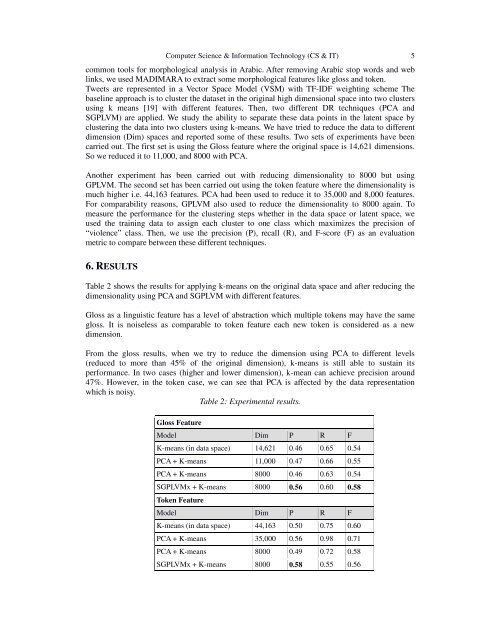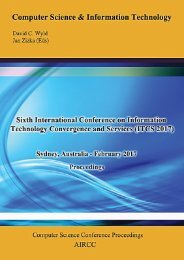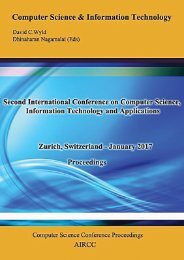CoSIT 2017
Fourth International Conference on Computer Science and Information Technology ( CoSIT 2017 ), Geneva, Switzerland - March 2017
Fourth International Conference on Computer Science and Information Technology ( CoSIT 2017 ), Geneva, Switzerland - March 2017
You also want an ePaper? Increase the reach of your titles
YUMPU automatically turns print PDFs into web optimized ePapers that Google loves.
Computer Science & Information Technology (CS & IT) 5<br />
common tools for morphological analysis in Arabic. After removing Arabic stop words and web<br />
links, we used MADIMARA to extract some morphological features like gloss and token.<br />
Tweets are represented in a Vector Space Model (VSM) with TF-IDF weighting scheme The<br />
baseline approach is to cluster the dataset in the original high dimensional space into two clusters<br />
using k means [19] with different features. Then, two different DR techniques (PCA and<br />
SGPLVM) are applied. We study the ability to separate these data points in the latent space by<br />
clustering the data into two clusters using k-means. We have tried to reduce the data to different<br />
dimension (Dim) spaces and reported some of these results. Two sets of experiments have been<br />
carried out. The first set is using the Gloss feature where the original space is 14,621 dimensions.<br />
So we reduced it to 11,000, and 8000 with PCA.<br />
Another experiment has been carried out with reducing dimensionality to 8000 but using<br />
GPLVM. The second set has been carried out using the token feature where the dimensionality is<br />
much higher i.e. 44,163 features. PCA had been used to reduce it to 35,000 and 8,000 features.<br />
For comparability reasons, GPLVM also used to reduce the dimensionality to 8000 again. To<br />
measure the performance for the clustering steps whether in the data space or latent space, we<br />
used the training data to assign each cluster to one class which maximizes the precision of<br />
“violence” class. Then, we use the precision (P), recall (R), and F-score (F) as an evaluation<br />
metric to compare between these different techniques.<br />
6. RESULTS<br />
Table 2 shows the results for applying k-means on the original data space and after reducing the<br />
dimensionality using PCA and SGPLVM with different features.<br />
Gloss as a linguistic feature has a level of abstraction which multiple tokens may have the same<br />
gloss. It is noiseless as comparable to token feature each new token is considered as a new<br />
dimension.<br />
From the gloss results, when we try to reduce the dimension using PCA to different levels<br />
(reduced to more than 45% of the original dimension), k-means is still able to sustain its<br />
performance. In two cases (higher and lower dimension), k-mean can achieve precision around<br />
47%. However, in the token case, we can see that PCA is affected by the data representation<br />
which is noisy.<br />
Table 2: Experimental results.<br />
Gloss Feature<br />
Model Dim P R F<br />
K-means (in data space) 14,621 0.46 0.65 0.54<br />
PCA + K-means 11,000 0.47 0.66 0.55<br />
PCA + K-means 8000 0.46 0.63 0.54<br />
SGPLVMx + K-means 8000 0.56 0.60 0.58<br />
Token Feature<br />
Model Dim P R F<br />
K-means (in data space) 44,163 0.50 0.75 0.60<br />
PCA + K-means 35,000 0.56 0.98 0.71<br />
PCA + K-means 8000 0.49 0.72 0.58<br />
SGPLVMx + K-means 8000 0.58 0.55 0.56





